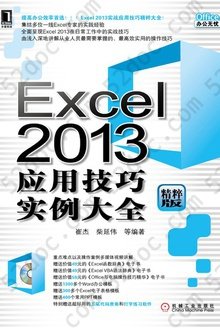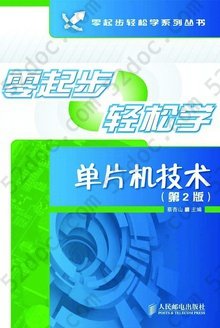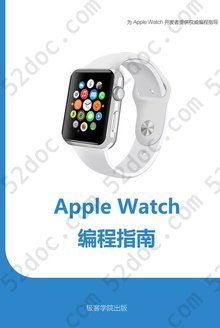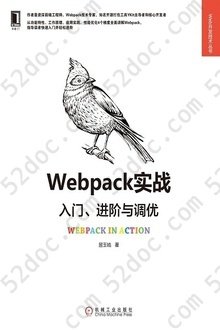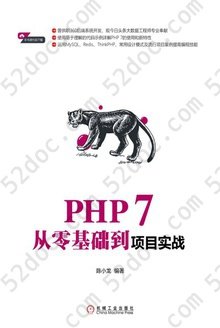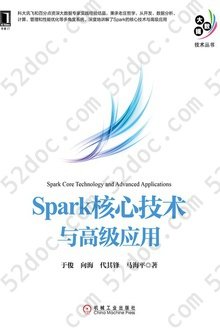注重体验与质量的电子书资源下载网站
分类于: 其它 人工智能
简介

Microservices in .NET Core: with examples in Nancy 豆 0.0分
资源最后更新于 2020-11-28 04:16:55
作者:Christian Horsdal
出版社:Manning Publications
出版日期:2017-01
ISBN:9781617293375
文件格式: pdf
标签: Microservice .NET 软件开发 设计模式 计算机 编程 架构
简介· · · · · ·
Microservices in .NET Core provides a complete guide to building microservice applications. After a crystal-clear introduction to the microservices architectural style, the book will teach you practical development skills in that style, using OWIN and Nancy. You'll design and build individual services in C# and learn how to compose them into a simple but functional application ...
目录
PART 1: GETTING STARTED WITH MICROSERVICES IN .NET
1. MICROSERVICES AT A GLANCE
1.1. What is a Microservice?
1.1.1. What is a Microservices Architecture?
1.1.2. Microservice Characteristics
1.2. Why Microservices?
1.2.1. Enabling Continuous Delivery
1.2.2. High Level of Maintainability
1.2.3. Resilient and Scalable
1.2.4. The Costs and Downsides of Microservices
1.2.5. Greenfield vs. Brownfield
1.2.6. Code Reuse?
1.3. Serving a User Request - An Example of How Microservices Work in Concert
1.3.1. Main Handling of the User Request
1.3.2. Side Effects of the User Request
1.3.3. The Complete Picture
1.4. A .NET Microservices Technology Stack
1.4.1. Nancy
1.4.2. OWIN
1.4.3. Setting Up a Development Environment
1.5. A Simple Microservices Example
1.5.1. Create an Empty ASP.NET 5 application
1.5.2. Add Nancy to the Projects
1.5.3. a Nancy Module with an Implementation of the Endpoint
1.5.4. Add an OWIN Middleware
1.6. Summary
2. A BASIC SHOPPING CART MICROSERVICE
2.1. Overview of the Shopping Cart Microservice
2.1.1. Components of the Shopping Cart Microservice
2.2. Implementing the Shopping Cart Microservice
2.2.1. Creating an Empty Project
2.2.2. The Shopping Cart Microservice's API for other services
2.2.3. Fetching Product Information
2.2.4. Parsing the Products Response
2.2.5. Adding a Failure Handling Policy
2.2.6. Implementing a Basic Event Feed
2.3. Running the Code
2.4. Summary
PART 2: BUILDING MICROSERVICES
3. IDENTIFYING AND SCOPING MICROSERVICES
3.1. The Primary Driver for Scoping Microservices: Business Capabilities
3.1.1. What is a Business Capability?
3.1.2. Identifying Business Capabilities
3.1.3. Example: Point of Sale System
3.2. The Secondary Driver for Scoping for Microservices: Supporting Technical Capabilities
3.2.1. What is a Technical Capability?
3.2.2. Examples of Supporting Technical Capabilities
3.2.3. Identifying Technical Capabilities
3.3. What to do When the Correct Scope is not Clear?
3.3.1. Sometimes Start a Bit Bigger
3.3.2. Carve Out New Microservices from Existing Microservices
3.3.3. Plan for Carving Out New Microservices Later
3.4. Well Scoped Microservices Adhere to the Microservice Characteristics
3.4.1. Primarily Scoping to Business Capabilities Leads to Good Microservices
3.4.2. Secondarily Scoping to Supporting Technical Capability Leads to Good Microservices
3.5. Summary
4. MICROSERVICE COLLABORATION
4.1. Types of Collaboration: Commands, Queries and Events
4.1.1. Commands and Queries: Synchronous Collaboration
4.1.2. Events: Asynchronous Collaboration
4.1.3. Data Formats
4.2. Implementing Collaboration
4.2.1. Setting Up a Project for the Loyalty Program Microservice
4.2.2. Implementing Commands and Queries
4.2.3. Implementing Commands with HTTP POST or HTTP PUT
4.2.4. Implementing Queries with HTTP GET
4.2.5. Data Formats
4.2.6. Implementing an Event Based collaboration
4.3. Summary
5. DATA OWNERSHIP AND DATA STORAGE
5.1. Each Microservice has a Data Store
5.2. How to Partition your Data Between Microservices?
5.2.1. Rule 1: Data Ownership Follows Business Capabilities
5.2.2. Rule 2: Replicate for Speed and Robustness
5.2.3. Where Does a Microservice Store its Data?
5.3. Implementing Data Storage in a Microservice
5.3.1. Storing Data Owned by the Microservice
5.3.2. Storing Events Raised by a Microservice
5.3.3. Setting Cache Headers in Nancy Responses
5.3.4. Reading and Using Cache Headers
5.4. Summary
6. DESIGN FOR ROBUSTNESS
6.1. Expect Failures
6.1.1. Have Good Logs
6.1.2. Roll forward vs Roll back
6.1.3. Do Not Propagate Failures
6.2. The Client Side of a Collaboration is Responsible for Robustness
6.2.1. Robustness Pattern: Retry
6.2.2. Robustness Pattern: Circuit Breaker
6.3. Implementing Robustness Patterns
6.3.1. Implementing a Fast Paced Retry Strategy with Polly
6.3.2. Implementing a Circuit Breaker with Polly
6.3.3. Implementing a Slow Paced Retry Strategy
6.3.4. Log All Unhandled Exceptions
6.4. Summary
7. WRITING TESTS FOR MICROSERVICES
7.1. What and How to Test
7.1.1. The Test Pyramid: What to Test in a Microservices System
7.1.2. System Level Tests: Testing a Complete Microservices System End-to-End
7.1.3. Service Level Tests: Testing a Microservice From Outside Its Process
7.1.4. Unit Level Tests: Testing Endpoints From Within the Process
7.2. Testing Libraries Used: Nancy.Testing and xUnit
7.2.1. Meet Nancy.Testing
7.2.2. Meet xUnit
7.2.3. xUnit and Nancy.Testing working together
7.3. Writing Unit Tests Using Nancy.Testing
7.3.1. Setup a Unit Test Project
7.3.2. Use the Browser Object to Unit Test Endpoints
7.3.3. Use Configurable Bootstrapper to Inject Mocks into Endpoints
7.4. Writing Service Level Tests
7.4.1. Create Service Level Test Project
7.4.2. Create Mocked Endpoints
7.4.3. Start All Processes of the Microservice Under Test
7.4.4. Execute Test Scenario Against the Microservice Under Test
7.5. Summary
PART 3: OPERATIONALIZING AND REUSING CROSS CUTTING CONCERNS
8. INTRODUCING OWIN: WRITING AND TESTING OWIN MIDDLEWARE
8.1. Handling Cross Cutting Concerns
8.2. The OWIN Pipeline
8.2.1. What Belongs in OWIN and What Belongs in Nancy?
8.3. Writing Middleware
8.3.1. Middleware as Lambdas
8.3.2. Middleware Classes
8.4. Testing Middleware and Pipelines
8.5. Summary
8.6. Further Reading
9. CROSS CUTTING CONCERNS: MONITORING AND LOGGING
9.1. Monitoring Needs in Microservices
9.2. Logging Needs in Microservices
9.2.1. Structured Logging with SeriLog
9.3. Implementing Monitoring Middleware
9.4. Implementing Logging Middleware
9.4.1. Adding a Correlation Tokens to All Log Messages
9.4.2. Adding a Correlation Token to All Outgoing HTTP Requests
9.4.3. Logging Requests and Request Performance
9.4.4. Configuring an OWIN Pipeline with Correlation Token and Logging Middleware
9.5. Summary
10. SECURING MICROSERVICE TO MICROSERVICE COMMUNICATION
10.1. Microservices Security Concerns
10.1.1. Authenticate Users at the Edge
10.1.2. Authorize Users In Microservices
10.1.3. How Much Should Microservices Trust Each Other?
10.2. Implementing Secure Microservice to Microservice Communication
10.2.1. Meet IdentityServer
10.2.2. Implementing Authentication With IdentityServer Middleware
10.2.3. Implementing Microservice-to-Microservice Authorization With IdentityServer and Middleware
10.2.4. Implementing User Authorization in Nancy Modules
10.3. Summary
11. BUILDING A REUSABLE MICROSERVICE PLATFORM
11.1. It Should be Quick and Easy to Create a New Microservice
11.2. Creating a Reusable Microservice Platform
11.3. Packaging and Sharing Middleware with NuGet
11.3.1. Creating a Package with Logging and Monitoring Middleware
11.3.2. Creating a Package with Authorization Middleware
11.3.3. Creating a Package with Rest Client Factory
11.3.4. Using the Microservice Platform in Microservice
11.4. Summary
PART 4: BUILDING APPLICATIONS
12. CREATING APPLICATIONS OVER MICROSERVICES
12.1. End User Applications for Microservice Systems: One or Many Applications?
12.1.1. General Purpose Applications
12.1.2. Specialized Applications
12.2. Patterns for Building Application over Microservices
12.2.1. Composite Applications
12.2.2. API GateWay
12.2.3. Backend for Frontend (The BFF Pattern)
12.3. Client Side or Server Side Rendering?
12.4. Example: A Product List and a Shopping Cart
12.4.1. Create an API Gateway
12.4.2. Create the Product List GUI
12.4.3. Create the Shopping Cart GUI
12.4.4. Allow to Add Products to the Shopping Cart
12.4.5. Allow to Remove Products from the Shopping Cart
12.5. Summary
APPENDIXES
APPENDIX A: DEVELOPMENT ENVIRONMENT SETUP
A.1. Set Up an IDE
A.1.1. Visual Studio 2015
A.1.2. Visual Studio Code
A.1.3. ATOM
A.1.4. Jetbrains Rider
A.2. Set Up Dotnet Command Line Interface
A.3. Setup Yeoman ASPNET Generator
A.4. Set Up Postman
A.5. Install SQL Server Express
APPENDIX B: DEPLOYING TO PRODUCTION
B.1. Deploying HTTP APIs
B.1.1. Windows Servers
B.1.2. Linux Servers
B.1.3. Azure Web Apps
B.1.4. Azure Service Fabric
B.2. Deploying Event Consumers
B.2.1. Windows Servers
B.2.2. Linux Servers
B.2.3. Azure Web Jobs
B.2.4. Azure Functions
B.2.5. Amazon Lambda
1. MICROSERVICES AT A GLANCE
1.1. What is a Microservice?
1.1.1. What is a Microservices Architecture?
1.1.2. Microservice Characteristics
1.2. Why Microservices?
1.2.1. Enabling Continuous Delivery
1.2.2. High Level of Maintainability
1.2.3. Resilient and Scalable
1.2.4. The Costs and Downsides of Microservices
1.2.5. Greenfield vs. Brownfield
1.2.6. Code Reuse?
1.3. Serving a User Request - An Example of How Microservices Work in Concert
1.3.1. Main Handling of the User Request
1.3.2. Side Effects of the User Request
1.3.3. The Complete Picture
1.4. A .NET Microservices Technology Stack
1.4.1. Nancy
1.4.2. OWIN
1.4.3. Setting Up a Development Environment
1.5. A Simple Microservices Example
1.5.1. Create an Empty ASP.NET 5 application
1.5.2. Add Nancy to the Projects
1.5.3. a Nancy Module with an Implementation of the Endpoint
1.5.4. Add an OWIN Middleware
1.6. Summary
2. A BASIC SHOPPING CART MICROSERVICE
2.1. Overview of the Shopping Cart Microservice
2.1.1. Components of the Shopping Cart Microservice
2.2. Implementing the Shopping Cart Microservice
2.2.1. Creating an Empty Project
2.2.2. The Shopping Cart Microservice's API for other services
2.2.3. Fetching Product Information
2.2.4. Parsing the Products Response
2.2.5. Adding a Failure Handling Policy
2.2.6. Implementing a Basic Event Feed
2.3. Running the Code
2.4. Summary
PART 2: BUILDING MICROSERVICES
3. IDENTIFYING AND SCOPING MICROSERVICES
3.1. The Primary Driver for Scoping Microservices: Business Capabilities
3.1.1. What is a Business Capability?
3.1.2. Identifying Business Capabilities
3.1.3. Example: Point of Sale System
3.2. The Secondary Driver for Scoping for Microservices: Supporting Technical Capabilities
3.2.1. What is a Technical Capability?
3.2.2. Examples of Supporting Technical Capabilities
3.2.3. Identifying Technical Capabilities
3.3. What to do When the Correct Scope is not Clear?
3.3.1. Sometimes Start a Bit Bigger
3.3.2. Carve Out New Microservices from Existing Microservices
3.3.3. Plan for Carving Out New Microservices Later
3.4. Well Scoped Microservices Adhere to the Microservice Characteristics
3.4.1. Primarily Scoping to Business Capabilities Leads to Good Microservices
3.4.2. Secondarily Scoping to Supporting Technical Capability Leads to Good Microservices
3.5. Summary
4. MICROSERVICE COLLABORATION
4.1. Types of Collaboration: Commands, Queries and Events
4.1.1. Commands and Queries: Synchronous Collaboration
4.1.2. Events: Asynchronous Collaboration
4.1.3. Data Formats
4.2. Implementing Collaboration
4.2.1. Setting Up a Project for the Loyalty Program Microservice
4.2.2. Implementing Commands and Queries
4.2.3. Implementing Commands with HTTP POST or HTTP PUT
4.2.4. Implementing Queries with HTTP GET
4.2.5. Data Formats
4.2.6. Implementing an Event Based collaboration
4.3. Summary
5. DATA OWNERSHIP AND DATA STORAGE
5.1. Each Microservice has a Data Store
5.2. How to Partition your Data Between Microservices?
5.2.1. Rule 1: Data Ownership Follows Business Capabilities
5.2.2. Rule 2: Replicate for Speed and Robustness
5.2.3. Where Does a Microservice Store its Data?
5.3. Implementing Data Storage in a Microservice
5.3.1. Storing Data Owned by the Microservice
5.3.2. Storing Events Raised by a Microservice
5.3.3. Setting Cache Headers in Nancy Responses
5.3.4. Reading and Using Cache Headers
5.4. Summary
6. DESIGN FOR ROBUSTNESS
6.1. Expect Failures
6.1.1. Have Good Logs
6.1.2. Roll forward vs Roll back
6.1.3. Do Not Propagate Failures
6.2. The Client Side of a Collaboration is Responsible for Robustness
6.2.1. Robustness Pattern: Retry
6.2.2. Robustness Pattern: Circuit Breaker
6.3. Implementing Robustness Patterns
6.3.1. Implementing a Fast Paced Retry Strategy with Polly
6.3.2. Implementing a Circuit Breaker with Polly
6.3.3. Implementing a Slow Paced Retry Strategy
6.3.4. Log All Unhandled Exceptions
6.4. Summary
7. WRITING TESTS FOR MICROSERVICES
7.1. What and How to Test
7.1.1. The Test Pyramid: What to Test in a Microservices System
7.1.2. System Level Tests: Testing a Complete Microservices System End-to-End
7.1.3. Service Level Tests: Testing a Microservice From Outside Its Process
7.1.4. Unit Level Tests: Testing Endpoints From Within the Process
7.2. Testing Libraries Used: Nancy.Testing and xUnit
7.2.1. Meet Nancy.Testing
7.2.2. Meet xUnit
7.2.3. xUnit and Nancy.Testing working together
7.3. Writing Unit Tests Using Nancy.Testing
7.3.1. Setup a Unit Test Project
7.3.2. Use the Browser Object to Unit Test Endpoints
7.3.3. Use Configurable Bootstrapper to Inject Mocks into Endpoints
7.4. Writing Service Level Tests
7.4.1. Create Service Level Test Project
7.4.2. Create Mocked Endpoints
7.4.3. Start All Processes of the Microservice Under Test
7.4.4. Execute Test Scenario Against the Microservice Under Test
7.5. Summary
PART 3: OPERATIONALIZING AND REUSING CROSS CUTTING CONCERNS
8. INTRODUCING OWIN: WRITING AND TESTING OWIN MIDDLEWARE
8.1. Handling Cross Cutting Concerns
8.2. The OWIN Pipeline
8.2.1. What Belongs in OWIN and What Belongs in Nancy?
8.3. Writing Middleware
8.3.1. Middleware as Lambdas
8.3.2. Middleware Classes
8.4. Testing Middleware and Pipelines
8.5. Summary
8.6. Further Reading
9. CROSS CUTTING CONCERNS: MONITORING AND LOGGING
9.1. Monitoring Needs in Microservices
9.2. Logging Needs in Microservices
9.2.1. Structured Logging with SeriLog
9.3. Implementing Monitoring Middleware
9.4. Implementing Logging Middleware
9.4.1. Adding a Correlation Tokens to All Log Messages
9.4.2. Adding a Correlation Token to All Outgoing HTTP Requests
9.4.3. Logging Requests and Request Performance
9.4.4. Configuring an OWIN Pipeline with Correlation Token and Logging Middleware
9.5. Summary
10. SECURING MICROSERVICE TO MICROSERVICE COMMUNICATION
10.1. Microservices Security Concerns
10.1.1. Authenticate Users at the Edge
10.1.2. Authorize Users In Microservices
10.1.3. How Much Should Microservices Trust Each Other?
10.2. Implementing Secure Microservice to Microservice Communication
10.2.1. Meet IdentityServer
10.2.2. Implementing Authentication With IdentityServer Middleware
10.2.3. Implementing Microservice-to-Microservice Authorization With IdentityServer and Middleware
10.2.4. Implementing User Authorization in Nancy Modules
10.3. Summary
11. BUILDING A REUSABLE MICROSERVICE PLATFORM
11.1. It Should be Quick and Easy to Create a New Microservice
11.2. Creating a Reusable Microservice Platform
11.3. Packaging and Sharing Middleware with NuGet
11.3.1. Creating a Package with Logging and Monitoring Middleware
11.3.2. Creating a Package with Authorization Middleware
11.3.3. Creating a Package with Rest Client Factory
11.3.4. Using the Microservice Platform in Microservice
11.4. Summary
PART 4: BUILDING APPLICATIONS
12. CREATING APPLICATIONS OVER MICROSERVICES
12.1. End User Applications for Microservice Systems: One or Many Applications?
12.1.1. General Purpose Applications
12.1.2. Specialized Applications
12.2. Patterns for Building Application over Microservices
12.2.1. Composite Applications
12.2.2. API GateWay
12.2.3. Backend for Frontend (The BFF Pattern)
12.3. Client Side or Server Side Rendering?
12.4. Example: A Product List and a Shopping Cart
12.4.1. Create an API Gateway
12.4.2. Create the Product List GUI
12.4.3. Create the Shopping Cart GUI
12.4.4. Allow to Add Products to the Shopping Cart
12.4.5. Allow to Remove Products from the Shopping Cart
12.5. Summary
APPENDIXES
APPENDIX A: DEVELOPMENT ENVIRONMENT SETUP
A.1. Set Up an IDE
A.1.1. Visual Studio 2015
A.1.2. Visual Studio Code
A.1.3. ATOM
A.1.4. Jetbrains Rider
A.2. Set Up Dotnet Command Line Interface
A.3. Setup Yeoman ASPNET Generator
A.4. Set Up Postman
A.5. Install SQL Server Express
APPENDIX B: DEPLOYING TO PRODUCTION
B.1. Deploying HTTP APIs
B.1.1. Windows Servers
B.1.2. Linux Servers
B.1.3. Azure Web Apps
B.1.4. Azure Service Fabric
B.2. Deploying Event Consumers
B.2.1. Windows Servers
B.2.2. Linux Servers
B.2.3. Azure Web Jobs
B.2.4. Azure Functions
B.2.5. Amazon Lambda



